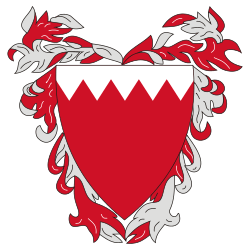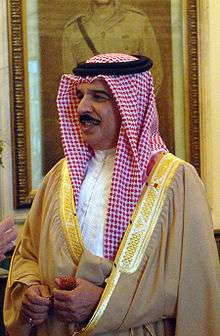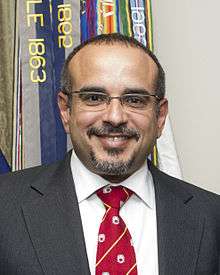Bahrain Defence Force
| Bahrain Defence Force قوة دفاع البحرين | |
|---|---|
 | |
| Service branches |
|
| Leadership | |
| Supreme Commander | Hamad bin Isa Al Khalifa |
| Commander in chief | Khalifa bin Ahmed Al Khalifa |
| Chief of Defense | Theyab bin Saqer Al Noaimi |
| Manpower | |
| Active personnel | 13,000 (approximate) |
| Expenditures | |
| Budget | $1.365 billion (2014) |
| Percent of GDP | 3.9% (2014) |
 |
| This article is part of a series on the politics and government of Bahrain |
The Military of Bahrain popularly known as Bahrain Defence Force (BDF) was under Bahrain's Ministry of Defence and a part of the government and is simply Bahrain Defence Force under a field marshal who is the commander-in-chief.
It numbers about 13,000 personnel[1] and consists of the Royal Bahraini Air Force, Royal Bahraini Army, Royal Bahraini Navy and the Bahrain Royal Medical Services. Apart from the BDF, the public security forces and the Coast Guard report to the Ministry of Interior.
In January 2008, the Crown Prince, Salman bin Hamad bin Isa Al Khalifa was appointed as the Deputy Supreme Commander,[2] while Khalifa bin Ahmed Al Khalifa was appointed as the Commander-in-Chief of the BDF.[3]
GCC support
Bahrain, in conjunction with its GCC partners has moved to upgrade its defenses in response to the threat posed by the Iran-Iraq and Persian Gulf wars.
In 1982, the GCC gave Bahrain $1.7 billion to help improve its defenses. Bahrain's defense spending since 1999 has been steady. The government spends around $320 million annually on their military.
U.S. support
After the Gulf War, Bahrain received additional military support from the United States, including the sale of 54 M60A3 tanks, 12 F-16C/D aircraft, and 14 Cobra helicopters. Joint naval, air and ground exercises also have been planned and executed to increase readiness throughout the Persian Gulf. Bahrain and the United States signed a Defense Cooperation Agreement in October 1991, granting U.S. forces access to Bahraini facilities and ensuring the right to pre-position material for future crises. In 2003, George W. Bush designated Bahrain as a major non-NATO ally of the United States. Since 2003, Bahrain has been granted over $100 million in Foreign Military Funding to pay for various high-profile weapons systems, to include an AN/TPS-59(v)3B Early Warning Radar, Large Aircraft Infrared Countermeasures (LAIRCM), Air-to-Air Missile Avoidance System for the King's Plane (Boeing 747-400), as well as an Avenger Air Defense Vehicle.
Commanders-in-Chief of the BDF
| # | Name | Picture | Took Office | Left Office |
|---|---|---|---|---|
| 1 | Hamad bin Isa Al Khalifa |  |
1969 | 1999 |
| 2 | Salman bin Hamad bin Isa Al Khalifa |  |
1999 | 2008 |
| 3 | Khalifa bin Ahmed Al Khalifa | picture | 2008 | Still |
See also
References
- ↑ "Bahrain". The 2011 US Department of State Background Notes. United States Department of State. Retrieved 2 March 2012.
The Bahrain Defense Force (BDF) numbers about 13,000 personnel.
- ↑ "Royal Decree No 1 of the Year 2008 on the Appointment of the Deputy Supreme Commander". Official Gazette of the Kingdom of Bahrain. 6 January 2008.
- ↑ "Royal Decree No 2 of the Year 2008 on the Appointment of the Commander-in-Chief of the Bahrain Defence Force". Official Gazette of the Kingdom of Bahrain. 6 January 2008.
External links
| Wikimedia Commons has media related to Bahrain Defence Force. |
- Background Note: Bahrain - Defense U.S. Department of State